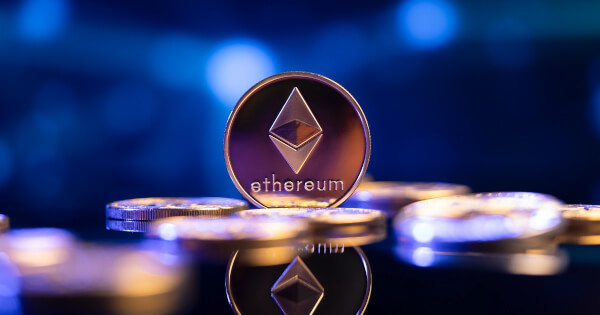ETH Merge Will Propel Narrative of Cryptos Being Eco-Friendly: Head of Sales at Moneycorp
Once Ethereum shifts to a PoS consensus mechanism, validators will replace miners in the confirmation of blocks because they will use the staked Ether. As a result, prompting a more cost-efficient and environmentally friendly approach.

As the Ethereum (ETH) merge slated for September 15 is a stone’s throw away, Blockchain.News conducted an exclusive interview with Anil Sawrup, the head of sales at Moneycorp Americas, to get more insights about what this much-anticipated event has to offer.
Despite the merge being the talk of the town, it has been elusive for quite some time because it was launched in December 2020 as Ethereum 2.0 or the beacon chain, and it sought to transition the current proof-of-work (PoW) framework to a proof-of-stake (PoS) consensus mechanism.
Nevertheless, various indicators show that September 15 is the most probable date for the merger. For instance, Vitalik Buterin, Ethereum’s co-founder, recently hinted that this date was the day to watch.
Speaking in an exclusive interview, Sawrup told Blockchain.News that since the ETH merge was in sight, it would undoubtedly change various narratives about the crypto space. He noted:
“I believe the merge will increase the scenario around crypto being environmentally friendly. Obviously, reducing emission costs and changing the whole blockchain theory.”
Since the PoW framework necessitates solving a cryptographic puzzle, it is energy-intensive, which pollutes the environment.
Once Ethereum shifts to a PoS consensus mechanism, validators will replace miners in the confirmation of blocks because they will use the staked Ether. As a result, prompting a more cost-efficient and environmentally friendly approach.
On the other hand, Sawrup stated that Bitcoin and Ethereum had emerged as notable equity market indicators. Therefore, this trend was likely to continue with the advent of the merger. He noted:
“Since everybody is looking forward to the merge based on the crypto winter, what we are finding more so Bitcoin and Ethereum are becoming the leading indicators of the equity market, which is very interesting.”
Is Ethereum’s deflationary aspect valid with the merge?
The burning mechanism introduced in the ETH ecosystem has played an instrumental role in slashing supply. Therefore, the merge is expected to continue cutting supply, leading to the notion that it will make Ethereum a deflationary asset.
“Everything that we are seeing and reading shows it will become deflationary with the cost coming down,” Sawrup told Blockchain.News in an interview.
A recent report by American multinational investment bank Citigroup Inc. or Citi pointed out that the merger would slash the overall Ether issuance by 4.2% annually, making it a deflationary and yield-bearing asset. Therefore, shifting to a PoS consensus mechanism would enhance Ethereum’s quest to become a store of value.
LuckyHash, a crypto service provider, had previously shared similar sentiments by noting that the merge would prompt a 1% annual deflation rate, Blockchain.News reported.
Therefore, based on slashed supply, Sawrup hinted in the interview that Ethereum’s price was likely to continue increasing in the long term and said:
“If you reduce the supply, the price is expected to increase based on market forces.”
The merge is anticipated to happen in two phases. The consensus layer upgrade, Bellatrix will prompt the merge awareness on the Beacon Chain or Ethereum 2.0 and is expected to happen around September 6.
On the other hand, Paris is the execution layer that will trigger the transition from a proof-of-work (PoW) to a proof-of-stake (PoS) consensus mechanism. It is slated for September 15.
Bridging the gap between the crypto and FX markets
As a leading payments fintech, Moneycorp recently launched a forex exchange (FX) liquidity management solution for crypto exchanges.
The FX liquidity solution is powered by APIs and is meant to bridge the gap between the foreign exchange and crypto markets by eliminating some of the high rates accrued.
During an interview with Blockchain.News, Sawrup stated:
“Since the blockchain or crypto is still considered a higher risk space, what we are finding is most of the exchanges or assets still need the fiat portion of moving money around the world even from a treasury. We come through our API channel, the FX liquidity, which helps bridge the gap between the foreign exchange and crypto markets because the fiat service is still needed.”
The FX liquidity solution is also meant to help financial institutions develop appropriate pricing mechanisms. Sawrup added:
“The current tier 3 and tier 4 financial institutions don’t have the pricing or the network to make sure that they are priced appropriately.”
Despite the crypto winter being experienced, Sawrup believes the dust will settle probably from next year because the market is currently correcting. He said:
“Volumes are down, but I think it’s a correction point. As we continue going through this high-interest rate environment and derisking, I think what we will see is things start settling down probably next year. We will see trade volumes start to come back into the crypto space from a retail perspective.”
Since the merge is around the corner, it remains to be seen how things play out in the ETH network, given that crypto exchange OKX recently unveiled precautionary measures ahead of this event.
Image source: Shutterstock
